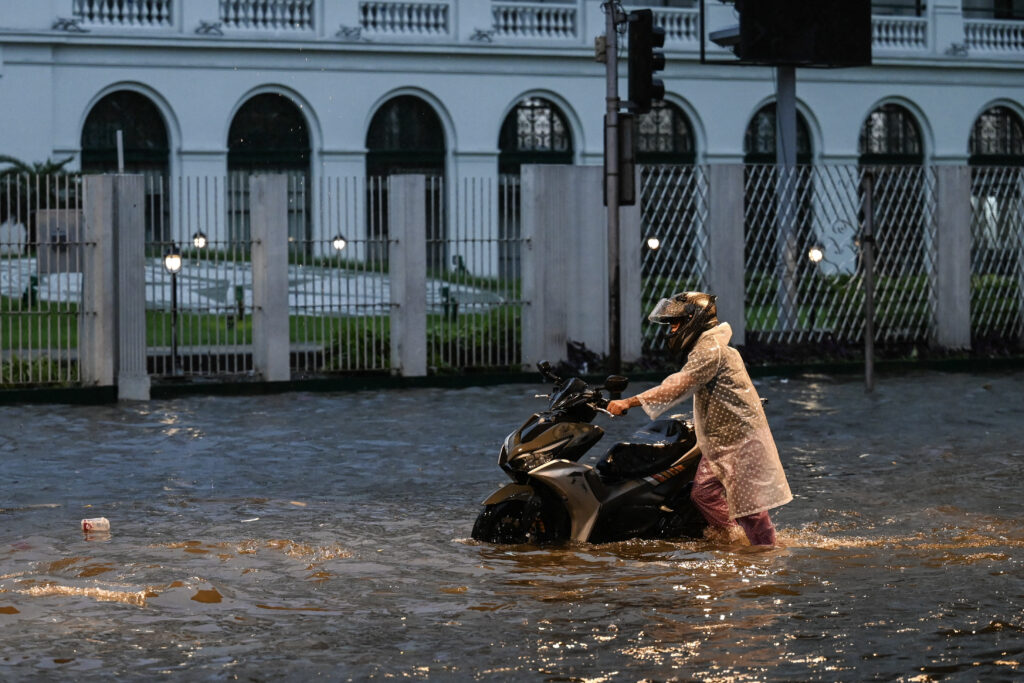
A man pushes his motorcycle along a flooded street in Manila on July 24, 2024 amid heavy rains brought by Typhoon Gaemi. (Photo by Jam Sta Rosa / AFP)
Relentless rain drenched the northern Philippines on Wednesday, triggering floods in Manila and landslides in mountainous regions as Typhoon Gaemi locally called Typhoon Carina intensified the seasonal monsoon.
In the densely populated capital, rescuers were deployed across the city to help evacuate people from low-lying homes after downpours turned streets into rivers, trapping vehicles.
READ MORE:
LIVE UPDATES: Tropical cyclones Butchoy, Carina
Taiwan prepares for typhoon that left 12 dead in Philippines
Marikina River update: 3rd alarm up; forced evacuation on
People clutched flimsy umbrellas as they waded through thigh-deep murky water or used small boats and shopping trolleys to move around.
“The disturbance it caused is great. The waters reached the second floor of our house,” Nora Clet, a homemaker, told AFP.
Restaurant employee Rex Morano said he wasn’t able to work due to the “very high” floodwaters.
A state of calamity was declared for Manila, unlocking funds for relief efforts, after the state weather forecaster warned of “serious flooding” in some areas.
Government offices were shut and classes suspended, at least 80 domestic and international flights were cancelled, and tens of thousands of customers lost power because of the weather.
Some shopping malls offered temporary shelter to people affected.
“Many areas are flooded so we have rescuers deployed all over the city. There is an overwhelming number of people asking for help,” Peachy de Leon, a disaster official in suburban Manila, told AFP.
“We were told last night the rain will not hit us, then the rain suddenly poured so we were quite shocked. There is an ongoing search and rescue now.”
Typhoon Cariona (International name: Gaemi), which has swept past the Philippines as it heads towards Taiwan, intensified the southwest monsoon rains typical for this time of year, the state weather forecaster said.
“Usually the peak of rainy season is July and August and it so happens that there is a typhoon in the eastern waters of the Philippines that enhances the southwest monsoon,” senior weather specialist Glaiza Escullar told AFP.
More than 200 millimetres (nearly eight inches) of rain fell in the capital in the past 24 hours, Escullar said, which was “not unusual”.
More heavy rain was expected on Thursday.
Landslides killed a pregnant woman and three children in Batangas province, south of Manila, and blocked three major roads in the mountainous Benguet province, police and disaster officials said Wednesday.
That takes the death toll from heavy rains over swaths of the country in the past two weeks to at least 12, as tens of thousands sheltered in evacuation centres.
President Ferdinand Marcos on Wednesday ordered disaster response officials to ensure they had sufficient stockpiles of food for the hardest-hit areas because “their situation is critical”.
Hard-scrabble neighbourhoods near Manila Bay were badly affected, with most of the streets under water and more than 2,000 people forced to flee their homes.
About 20 big storms and typhoons hit the Philippines or its surrounding waters each year, damaging homes and infrastructure and killing hundreds of people.